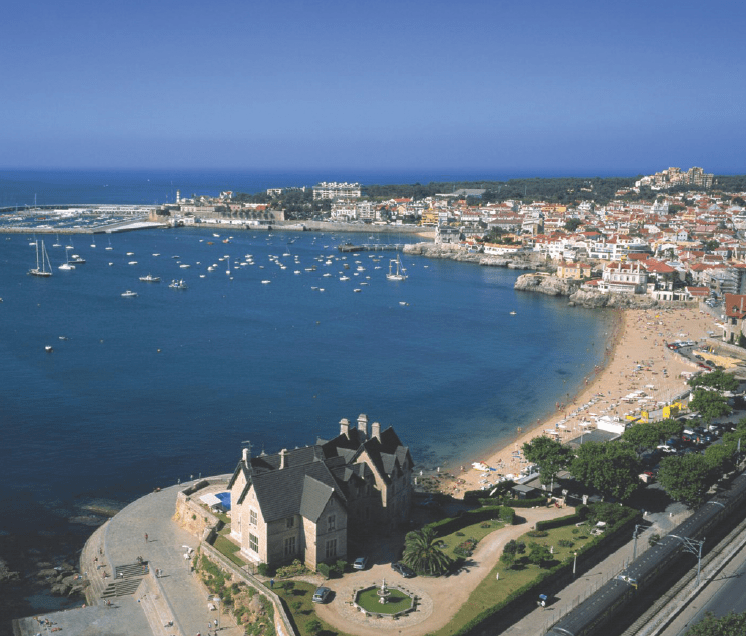It’s more than ironic that the great Portuguese explorers like Ferdinand Magellan and Vasco da Gama discovered much of the world in the 15th and 16th centuries yet 500 years later, even some of the most intrepid Americans have yet to visit Portugal—and its captivating coastal capital, Lisbon.
That’s changing. Today, seduced by its ancient, untrammeled beauty, flavor-infused foods, world class wines, sunny skies and bargain prices, Americas are flocking to a country
the size of Maine. Visitors from the U.S. have been growing 30% annually for the last few years. Yet Portugal never feels crowded, cluttered or tourist infested.
GETTING THERE
From Tampa-St. Pete airport, it’s an easy trip. A short JetBlue hop to Miami International and a fast connection to a TAP Air Portugal nonstop to Lisbon. Unlike many foreign flag carriers, the minute you step aboard the widebody Airbus A-330, with its surprisingly inexpensive coach, premium economy and roomy executive class seating, you immerse instantly into the Portuguese culture. I found in-flight service caring, responsive and polite.
The flight from Florida is an overnighter, arriving at 5 am when the airport is virtually empty and customs/immigration clearance, was swift. Lisbon is known as the easiest gateway from the U.S. into Europe. Here’s an insider tip: TAP has a free stopover scheme where you can spend five days in Lisbon and continue on one of 62 other TAP flights anywhere else in Europe, Russia or Africa.
However, most Floridians on my flight wanted to explore Portugal, venture out to the nine inhabited Azore islands with their powder white beaches and turquoise waters, or head straight to Porto and ther Douro Valley in the northern provinces where the world’s most exquisite and complex port wines are ‘fortified’ with brandy for taste, bottled, aged, uncorked and enjoyed. Another nearby destination for discriminating lovers of sweet wines, Madeira, is a quick connecting flight away.
LISBON UNVEILED
As a first timer, Lisbon enchanted me.The city is a little like San Francisco, hilly, with bridges, nearly surrounded by water, its sidestreets lined with stylish shops, bistros and bars filled with
welcoming locals who probably never cook at home. Lisbon, no surprise, is very European with narrow, crooked, cobblestone paths and alleys the lead nowhere and with storefronts and inner sanctums that beckon to your inner Magellan or Da Gama and challenges your navigational skills.
DINE, DRINK & SHOP
For example, I love historical bars that are honeycombed with storied adventures of cocktails past and their imbibers and their bartenders. Fellow local imbibers implored me to visit the quirky legendary Chinese Pavilion and swore on their sainted mothers’ soul it wasn’t some chop suey palace that poured Shanghai beer. I finally found the block where it was supposedly located, R Dom Pedro V89, but couldn’t find the front door. The sign was obscured. There was nothing Chinese about it.
At 6 pm sharp, a tall, wall aged wooden door creaked open and inside was a musty 19th century former grocery store with high ceilings, a warren of rooms, a few stools at a bar and toys from the first and second world war, hanging and sitting everywhere. It was a time machine, a hideout for patrons of the libational arts. Handsome barmen with engaging personalities were at my service. “I am Apolinio, the finest bartender in all of Lisbon,” roared a silver haired gent. “And this is Pedro, the worst barman in tall of Portugal. Pray that he doesn’t make your drink. Now what would you like?”
I liked the refreshing gin and tonic that Apolinio skillfully mixed for me for US$11 but it somehow seemed more exciting when I discovered that former British prime minister Tony Blair and Russian president Vladimir Putin bellied up to the very same spot in the bar, separately not together, years earlier, flanked, no doubt by their bodyguards. I drank solo but quickly made friends with a handful of in-the-know locals and fellow travelers. I found the Portuguese to be initially reserved but they thaw quickly if your questions show genuine interest. Unlike neighboring Italians and Spaniards, they are not dramatic, emotional souls.
Lisbon is a delightfully walkable city, safe, clean but filled with Ubers, taxis and hop on, hop off streetcars. English is spoken almost everywhere. The small central city of just 600,000 mixes whimsy with its antiquities. For instance, the lowly sardine is virtually worshipped in Lisbon, dating back to 1195 when patron saints sermonized fishes. There are sardine shops piled high with designer tins of the tiny critters and they are on almost every menu, eaten any time of day. Flags and mobiles fly honoring the sardine. A colorful, packed tin is a cherished souvenir. It’s the American hot dog of Portugal.
Indeed, food and dining and conversation are national pastimes in Lisbon. Leisure is savored. For some unexplainable reason, stress is neither visible nor felt nor communicated. It must largely sunny climes and the serenity of the everpresent sea. Outdoor cafes and coffee and many serve up what seems to be the national drink year-round—white port wine and tonic. Portugal’s unofficial libation is Ginjinha, a thick, sweet liqueur made from sour cherries and sipped from a chocolate shot glass. And if the sardine is lionized, cod is the holy grail. I had lunch in a lovely restaurant where virtually the entire menu was cod, everything except the dessert. The Portuguese, passionate about preserving their heritage, do not bend to trends.
“Theirs is no Portuguese fast food—no pizza, no hamburger,” said Thomas, a waiter at a popular dining hangout, Can The Can. “For us, it’s seafood and wine in all variations. The food scene is vibrant, influenced by the immigrants of former African colonies to Arabian and Iberian cuisines. Carnivores aren’t shortchanged. Sirloin, sometimes topped with a slice of cured ham, pork belly or a cooked egg, is a delicious diversion.
NAVIGATING PORTUGAL
Atop your ‘don’t miss’ list is the Sao Jorge Castle, a majestic Moorish fortified citadel sitting high above central Lisbon, built in the 11th century, partially destroyed and restored several times.(Lisbon is sprinkled with live archeological digs for latter day explorers). Celebrating its past is the 171 ft. high Monument to Discoveries shaped like a ship’s prow, located on the Tagus River shoreline.
Lisbon is filled with museums that cover the cultural waterfront. Some are quirky such as the Museu da Farmacia, a pharmacy museum, the Museum Nactional dos Coches, touted as housing the world’s largest collection of horse-drawn carriages and coaches.
A must-see is the new Museum for Art, Architecture and Technology which itself is an architectural thrill. Nactional de Arte Antiga, Portugal’s fine art gallery, is a wonder for wanderers. For me, the Museu do Ar or Air Museum of Portugal in nearby Sintra was the most riveting where thE “dream of flight” started with a winged suit donned by a doctor in 1540. He crashed. But the collection of commercial and military aircraft is nostalgic and uplifting.
Lisbon has its share of luxury hotels at four-star prices including the Hotel Britania, Eurostars Das Letras, Intercontinental and the Corinthia. But I found the Dom Pedro Lisboa, a four-and-half-star jewel, to be virtually perfect for under $150 a night. And that included a not quite but close Las Vegas style breakfast buffet. Rooms are spacious, staff is gracious, Internet is fast and the location is central. Guests are mostly Europeans, on holiday or doing business, and mercifully, no conventioneers.




